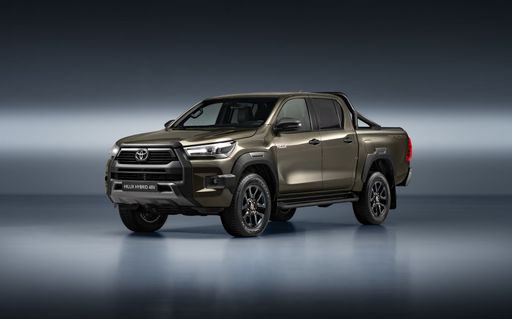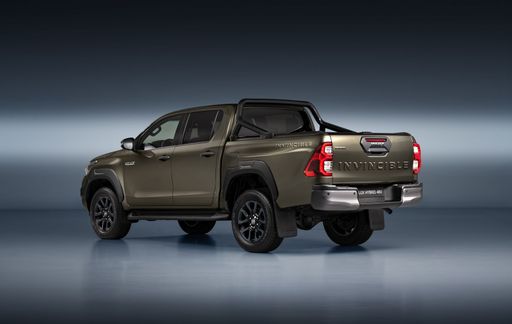The automotive sector is continuously evolving, and when it comes to rugged pickup trucks, two names stand tall: the Isuzu D-Max and the Toyota Hilux. Both vehicles are lauded for their reliability, performance, and utility. In this article, we’ll delve into a comprehensive comparison of the Isuzu D-Max versus the Toyota Hilux, examining their technical specifications, innovations, and overall driving experience.
Isuzu D-Max vs Toyota Hilux – Which car suits you better?
Compare performance, boot capacity, efficiency and price at a glance.
Find out which car is the better choice for you – Isuzu D-Max or Toyota Hilux?
Performance and Powertrain
The Isuzu D-Max comes equipped with a 1.9-liter diesel engine, producing a robust 163 horsepower (HP) with a torque of 360 Nm. This power enables the vehicle to accelerate from 0-100 km/h in a respectable 12.6 seconds, reaching a top speed of 180 km/h. Furthermore, the D-Max offers versatility in transmission options, providing both a manual and an automatic gearbox for driver preference.
On the other hand, the Toyota Hilux is powered by a slightly larger 2.4-liter diesel engine, generating 150 HP and 400 Nm of torque. With a 0-100 km/h acceleration time of 12.8 seconds, and a maximum speed of 170 km/h, the Hilux is not far behind its competitor. However, it comes exclusively with an automatic transmission, which streamlines the driving experience but may limit personal choice.
Fuel Efficiency and Environmental Impact
When it comes to fuel efficiency, the Isuzu D-Max performs competitively, with a consumption range of 8.1 to 9.2 L/100 km, depending on driving conditions and load. Its CO2 emissions vary, with figures around 212 to 240 g/km, slightly higher than ideal but acceptable for its class.
The Toyota Hilux shows a fuel consumption of about 8.7 L/100 km and CO2 emissions at 227 g/km. While the Hilux may be marginally less efficient, both models reflect a commitment to balancing power and consumption, aligning with global trends towards sustainability.
Dimensions and Capacity
In terms of size, the Isuzu D-Max is slightly larger, measuring 5310 mm in length, while the Toyota Hilux is 5325 mm. The D-Max, with a width of 1810 mm, is slightly narrower compared to the Hilux at 1855 mm. Height-wise, the D-Max stands at 1770 mm versus the Hilux’s 1815 mm. This may slightly influence their off-road capabilities, with the taller Hilux offering better ground clearance.
Both trucks can comfortably seat five passengers, but the D-Max also offers a two-door variant aimed at more utility-focused users. The payload capacities reflect their rugged utility: the D-Max can carry an impressive payload of 1130 kg, while the Hilux holds around 1025 kg.
Interior Comfort and Innovations
Inside the cabin, both vehicles have made strides in ergonomics and features. The Isuzu D-Max incorporated modern design elements with superior infotainment systems, providing connectivity and ease of use. Its spacious interior is user-friendly, suitable for both work and leisure drivers.
The Toyota Hilux, known for its durability, offers a functional interior complete with robust materials designed to withstand the rigors of heavy use. Innovations such as advanced safety features, including a comprehensive suite of airbags and stability control, are standard, ensuring a secure driving experience.
Off-Road Capabilities
One of the vital aspects of any pickup is its off-road prowess. The Isuzu D-Max's all-wheel-drive capabilities, along with its high ground clearance, contribute to its impressive off-road performance. Whether conquering rocky landscapes or navigating through mud, the D-Max proves itself as a formidable competitor.
Similarly, the Toyota Hilux has a revered reputation for off-road capability, courtesy of its rugged chassis and powerful four-wheel-drive system. Features such as Hill Start Assist and Active Traction Control further enhance its ability on challenging terrains.
Final Thoughts
Both the Isuzu D-Max and Toyota Hilux present compelling arguments as top-tier pickup trucks. While the D-Max offers slightly better power and payload capacity, the Hilux shines in durability and established off-road legacy. Ultimately, the choice between these two remarkable pickups will depend on personal preferences, specific use cases, and brand loyalty. Regardless of the decision, both models stand as testaments to what modern engineering can achieve in the world of automotive innovation.
Here’s where it gets real: The technical differences in detail
Costs and Efficiency:
Price and efficiency are key factors when choosing a car – and this is often where the real differences emerge.
Isuzu D-Max has a to a small extent advantage in terms of price – it starts at 34300 £, while the Toyota Hilux costs 39800 £. That’s a price difference of around 5482 £.
Fuel consumption also shows a difference: Isuzu D-Max manages with 8.70 L and is therefore slightly more efficient than the Toyota Hilux with 9.70 L. The difference is about 1 L per 100 km.
Engine and Performance:
Power, torque and acceleration say a lot about how a car feels on the road. This is where you see which model delivers more driving dynamics.
When it comes to engine power, the Toyota Hilux has a evident edge – offering 204 HP compared to 163 HP. That’s roughly 41 HP more horsepower.
In terms of top speed, the Isuzu D-Max performs minimal better – reaching 180 km/h, while the Toyota Hilux tops out at 175 km/h. The difference is around 5 km/h.
There’s also a difference in torque: Toyota Hilux pulls noticeable stronger with 500 Nm compared to 360 Nm. That’s about 140 Nm difference.
Space and Everyday Use:
Whether family car or daily driver – which one offers more room, flexibility and comfort?
Both vehicles offer seating for 5 people.
In curb weight, Isuzu D-Max is hardly perceptible lighter – 1905 kg compared to 2085 kg. The difference is around 180 kg.
When it comes to payload, Toyota Hilux slight takes the win – 1125 kg compared to 1095 kg. That’s a difference of about 30 kg.
Who wins the race?
The Toyota Hilux proves to be secures victory with a clear margin and therefore becomes our DriveDuel Champion!
Toyota Hilux is the better all-rounder in this comparison.
 @ Toyota Motor Corporation
@ Toyota Motor Corporation
Toyota Hilux
Isuzu D-Max
The Isuzu D-Max stands out in the pickup truck market with its robust design and impressive durability, making it a reliable choice for both work and leisure. Its interior blends practicality with a touch of comfort, featuring user-friendly technology that enhances the driving experience. This vehicle's off-road capabilities and strong performance make it a versatile companion for tackling a variety of terrains.
detailsToyota Hilux
The Toyota Hilux has long been celebrated for its remarkable durability and reliability, making it a favourite among those needing a robust vehicle for rugged terrains. Known for its unyielding performance, the Hilux combines practicality with a surprisingly comfortable driving experience, both on and off the road. With its distinctive design and advanced safety features, it continues to be a versatile choice for adventurers and professionals alike.
details @ Toyota Motor Corporation
@ Toyota Motor Corporation
 @ Toyota Motor Corporation
@ Toyota Motor Corporation
 @ Toyota Motor Corporation
@ Toyota Motor Corporation
|
|
|
|
|
Costs and Consumption |
|
|---|---|
|
Price
34300 - 50100 £
|
Price
39800 - 56200 £
|
|
Consumption L/100km
8.7 - 9 L
|
Consumption L/100km
9.7 - 10 L
|
|
Consumption kWh/100km
-
|
Consumption kWh/100km
-
|
|
Electric Range
-
|
Electric Range
-
|
|
Battery Capacity
-
|
Battery Capacity
-
|
|
co2
228 - 235 g/km
|
co2
253 - 264 g/km
|
|
Fuel tank capacity
76 L
|
Fuel tank capacity
80 L
|
Dimensions and Body |
|
|---|---|
|
Body Type
Pickup
|
Body Type
Pickup
|
|
Seats
2 - 5
|
Seats
4 - 5
|
|
Doors
2 - 4
|
Doors
2 - 4
|
|
Curb weight
1905 - 2110 kg
|
Curb weight
2085 - 2295 kg
|
|
Trunk capacity
-
|
Trunk capacity
-
|
|
Length
5280 - 5320 mm
|
Length
5325 mm
|
|
Width
1810 - 1870 mm
|
Width
1855 mm
|
|
Height
1770 - 1790 mm
|
Height
1810 - 1815 mm
|
|
Max trunk capacity
-
|
Max trunk capacity
-
|
|
Payload
990 - 1095 kg
|
Payload
915 - 1125 kg
|
Engine and Performance |
|
|---|---|
|
Engine Type
Diesel
|
Engine Type
Diesel MHEV, Diesel
|
|
Transmission
Automatic
|
Transmission
Automatic, Manuel
|
|
Transmission Detail
Automatic Gearbox
|
Transmission Detail
Automatic Gearbox, Manual Gearbox
|
|
Drive Type
All-Wheel Drive
|
Drive Type
All-Wheel Drive
|
|
Power HP
163 HP
|
Power HP
150 - 204 HP
|
|
Acceleration 0-100km/h
12.60 s
|
Acceleration 0-100km/h
-
|
|
Max Speed
180 km/h
|
Max Speed
170 - 175 km/h
|
|
Torque
360 Nm
|
Torque
400 - 500 Nm
|
|
Number of Cylinders
4
|
Number of Cylinders
4
|
|
Power kW
120 kW
|
Power kW
110 - 150 kW
|
|
Engine capacity
1898 cm3
|
Engine capacity
2393 - 2755 cm3
|
General |
|
|---|---|
|
Model Year
2024 - 2025
|
Model Year
2024 - 2025
|
|
CO2 Efficiency Class
G
|
CO2 Efficiency Class
G
|
|
Brand
Isuzu
|
Brand
Toyota
|
Is the Isuzu D-Max offered with different drivetrains?
The Isuzu D-Max is offered with All-Wheel Drive.
The prices and data displayed are estimates based on German list prices and may vary by country. This information is not legally binding.
